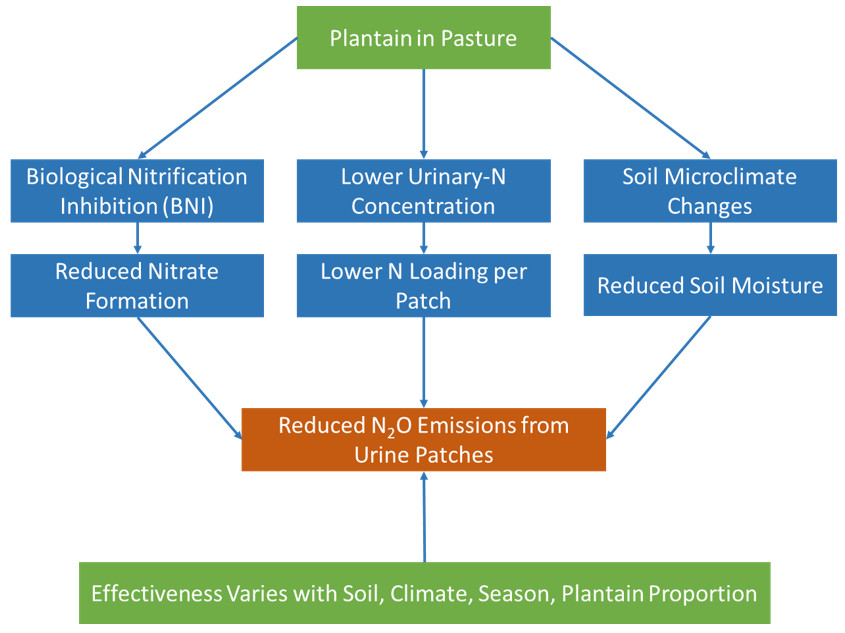Can incorporation of plantain into pasture reduce nitrous oxide emissions from urine patches in livestock grazing systems?
Nitrous oxide (N₂O) emissions from grazed pastures primarily originate from nitrogen (N)-rich livestock urine patches. Following deposition, urine-N undergoes microbial nitrification and denitrification, leading to N₂O losses. Developing mitigation strategies for this potent greenhouse gas therefore remains a research priority. The incorporation of plantain (Plantago lanceolata) into grazed swards has emerged as a promising approach, but just how this works is unclear. Scientists from the Bioeconomy Science Institute’s AgResearch Group have been looking into this question, with support from the Ministry for Primary Industries and the Ag Emissions Centre.
One proposed mechanism is biological nitrification inhibition (BNI). Plantain roots and decaying tissues could release secondary metabolites, such as aucubin and catalpol, which can suppress the activity of ammonia-oxidising microorganisms. This slows the conversion of ammonium-N to nitrate-N, thus reducing the nitrate-N substrate supply for denitrification and subsequent N₂O production. Another possible mechanism is the alteration of N excretion patterns in grazing livestock. Diets containing plantain have been shown to increase urination frequency while decreasing urinary-N concentration. This results in a more even spatial distribution of urine-N and a lower N loading per patch, reducing the magnitude of localised N₂O fluxes.
Plantain may also influence the soil microclimate. Compared with perennial ryegrass, plantain has a different canopy structure and rooting pattern, which may increase evapotranspiration and reduce soil water content. Lower water-filled pore space can constrain denitrification rates, thereby reducing N₂O emissions. Also, differences in ground cover and canopy density between plantain and ryegrass–white clover mixtures could alter soil temperature and aeration, indirectly influencing N₂O production pathways.
Although several mechanisms have been proposed (see figure for a summary), the evidence remains inconclusive. In New Zealand, plantain swards have reduced urine-derived N₂O emissions compared with ryegrass pastures, but the effects are inconsistent. Mitigation appears greater on free-draining Allophanic Soils than on poorly drained Gley Soils, and studies suggest that both reduced-N urine and soil–plant interactions contribute.
Several factors probably contribute to the variability in measured effects. These include differences in soil properties, seasonal soil moisture and temperature regimes, urine-N application rates, the age and botanical composition of plantain stands, and the proportion of plantain in the pasture mix. For example, the potential for BNI to operate effectively depends on the persistence of inhibitory compounds in the rhizosphere and the balance between plant uptake and microbial transformation of N, which may vary with plant growth stage and environmental conditions. Similarly, the dilution of urine-N is influenced by animal diet composition and grazing behaviour, which can be affected by pasture quality and seasonal growth patterns.
Overall, the incorporation of plantain into pastures presents a biologically and agronomically feasible means of reducing N₂O emissions from urine patches, with multiple potentially complementary mechanisms involved. The use of plantain in grazed pastures as an N₂O mitigation strategy is also gaining traction internationally with research projects underway in, among other countries, Ireland, Belgium, Switzerland, and The Netherlands.
However, inconsistent results among these studies highlight the need for ongoing research under both controlled and field conditions to disentangle the relative contributions of each mechanism and determine the combinations of soil, climate, and management factors under which plantain is most effective. Such information will be essential for developing robust recommendations for integrating plantain into grazing systems as part of a broader greenhouse gas mitigation strategy. The recent approval for a BNI flagship project by the Global Research Alliance on Agricultural Greenhouse Gases will provide increasing opportunities for global coordination and collaboration on BNI research.

Potential mechanisms by which plantain (Plantago lanceolata) may reduce N₂O emissions from urine patches.
Key contact
Jiafa Luo
Principal Scientist, Environmental Research team
Bioeconomy Science Institute, AgResearch Group
